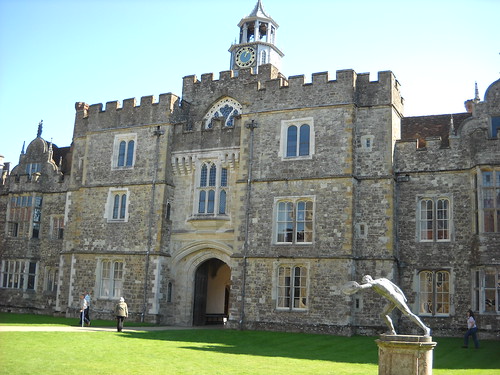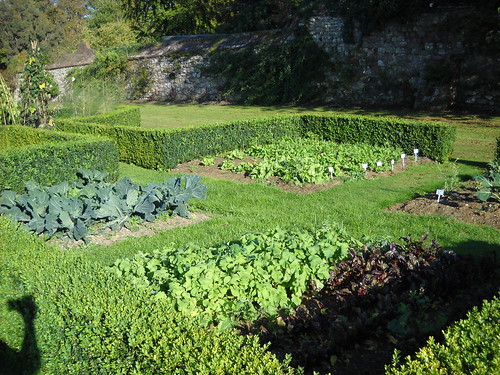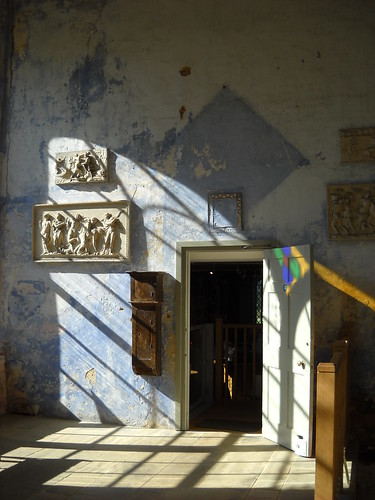What has 365 rooms, 52 staircases, 12 entrances, and 7 courtyards? Answer: A Calendar House. A handful of notable examples can be found in Britain and I get to study one of them (I love my job! And whoever says being a postgraduate student isn't a job was obviously never a postgraduate student!).
 |
The Green Court at Knole
One of the largest country houses in England, Knole sits in the middle of a 1,000 acre Medieval deer park, the only one of its kind remaining in Kent. It takes its name from the grassy knoll on which it has been sitting for over 500 years.
|
| Knowl illustrated by Kip and Knyff circa 1709 |
Knole is perhaps best known in gardening circles as the birthplace of Vita Sackville-West, who created the famous gardens at Sissinghurst Castle. The only child of the 3rd Lord Sackville, Vita was prevented from inheriting her beloved home thanks to the laws of primogeniture. The house, land, and title were passed to her uncle. Upon his death, the title, etc. went to a cousin, from whom the incumbent Lord Sackville is descended. The National Trust now owns the house and 43-acres of deer park, the rest is still owned by the Sackville-West family who have a 200 year lease and currently inhabit half the house. I wouldn't feel too bad for Vita, though; she did get Sissinghurst, after all!
One has to wonder, then, how different Knole would be had Vita inherited, being the keen gardener that she was. As it is, the 26-acre private family garden is only open to the public one day a week, at the discretion of the current tenant, the 7th Lord Sackville.
Amazingly, there are only 2 full-time, 2 seasonal, and 2 student trainee gardeners to care for the family gardens which feature formal planting and wilderness areas. Without a map, and with only an hour to roam, I was afraid of becoming hopelessly lost and so didn't see everything I would have liked to see. As I wandered, I kept fighting off the voice in my head of Maintenance Manager that kept pointing out issues: weeds here, grass that needed mowing there, trees that needed tending, ponds that needed cleaning, etc. No volunteers are used to help with the gardens and while there can be no question as to their enthusiasm, I sometimes have considerable hesitations about a volunteer's level of knowledge and ability. The bottom line is, many world famous gardens simply wouldn't exist today if weren't for their help, and surely a few extra hands to deadhead and pull weeds would make a big difference in the feel of the garden at Knole.
This Google map shows the gardens in relation to the house, surrounded by the deer park and ancient golf course. |
Kidding. The golf course is a modern amendment, dating to the early 1920's. It proved challenging during the second World War as the club members sought new and ingenious methods of obstructing the fairways to prevent enemy planes or gliders from landing. Being that Knole is located so close to 'Bomb Alley', the flight path the Luftwaffe took to and from their bombing raids of London, there are still some bomb craters evident in the park as the Germans ditched any bombs they had left on their way back to the
Vaterland.
But I digress. We were talking about the garden, weren't we? It was originally laid out 300 years ago as series of geometric squares and rectangles planted as orchard and managed to escape the ravages of fashion during the English Landscape Movement. Considerable change can be seen in this image, drawn by Thomas Badeslade in the 1719.
 |
| 1st-art-gallery.com |
Today most of the orchard has been replaced with a wilderness of beech, oak,
Liriodendron, one truly amazing
Cedrus, and a number of rhododendrons. Mossy paths curve out of sight, inviting you to enter and wander. As someone in my class group said, it's a good place to run around naked! A rose garden has been replaced with veg contained within a knotted boxwood hedge and a sunken pond has been turned into a swimming pool.
 |
| veggie garden |
Behind the enclosed herb garden is a tennis court, itself enclosed by a decidedly un-ornamental and decidedly not 17th century black chain-link fence. The herb garden was probably one of my favorite spots but it suffers from a lack of seating. It's a tease, this garden, because once inside you want to linger but aside from displacing the little cherubim from his seat on the dolphin, there is no place to sit and enjoy the herb's perfume.
 |
| Walled herb garden |
The garden and park at Knole are this term's case study for the Historic Garden Conservation course I'm taking. We have been invited by the present Lord Sackville to study Knole and develop a conservation management plan so you will hear more about the challenges of conserving and restoring an historical family home right here. So far my favorite part of research is the literary aspect, and for homework I have to read Vita's novel The Edwardians, which she based on life at Knole.
Did I mention I love my job!?
 |
| The newly opened Orangery |









No comments:
Post a Comment